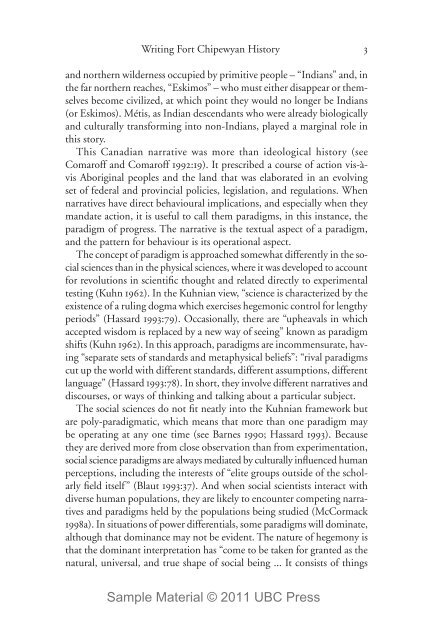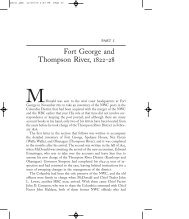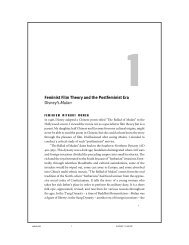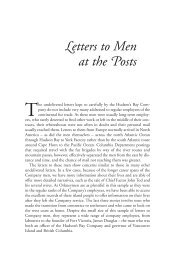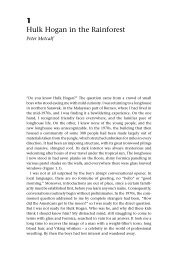Fort Chipewyan and the Shaping of Canadian History ... - UBC Press
Fort Chipewyan and the Shaping of Canadian History ... - UBC Press
Fort Chipewyan and the Shaping of Canadian History ... - UBC Press
You also want an ePaper? Increase the reach of your titles
YUMPU automatically turns print PDFs into web optimized ePapers that Google loves.
Writing <strong>Fort</strong> <strong>Chipewyan</strong> <strong>History</strong><br />
<strong>and</strong> nor<strong>the</strong>rn wilderness occupied by primitive people – “Indians” <strong>and</strong>, in<br />
<strong>the</strong> far nor<strong>the</strong>rn reaches, “Eskimos” – who must ei<strong>the</strong>r disappear or <strong>the</strong>mselves<br />
become civilized, at which point <strong>the</strong>y would no longer be Indians<br />
(or Eskimos). Métis, as Indian descendants who were already biologically<br />
<strong>and</strong> culturally transforming into non-Indians, played a marginal role in<br />
this story.<br />
This <strong>Canadian</strong> narrative was more than ideological history (see<br />
Comar<strong>of</strong>f <strong>and</strong> Comar<strong>of</strong>f 1992:19). It prescribed a course <strong>of</strong> action vis-àvis<br />
Aboriginal peoples <strong>and</strong> <strong>the</strong> l<strong>and</strong> that was elaborated in an evolving<br />
set <strong>of</strong> federal <strong>and</strong> provincial policies, legislation, <strong>and</strong> regulations. When<br />
narratives have direct behavioural implications, <strong>and</strong> especially when <strong>the</strong>y<br />
m<strong>and</strong>ate action, it is useful to call <strong>the</strong>m paradigms, in this instance, <strong>the</strong><br />
paradigm <strong>of</strong> progress. The narrative is <strong>the</strong> textual aspect <strong>of</strong> a paradigm,<br />
<strong>and</strong> <strong>the</strong> pattern for behaviour is its operational aspect.<br />
The concept <strong>of</strong> paradigm is approached somewhat differently in <strong>the</strong> social<br />
sciences than in <strong>the</strong> physical sciences, where it was developed to account<br />
for revolutions in scientific thought <strong>and</strong> related directly to experimental<br />
testing (Kuhn 1962). In <strong>the</strong> Kuhnian view, “science is characterized by <strong>the</strong><br />
existence <strong>of</strong> a ruling dogma which exercises hegemonic control for lengthy<br />
periods” (Hassard 1993:79). Occasionally, <strong>the</strong>re are “upheavals in which<br />
accepted wisdom is replaced by a new way <strong>of</strong> seeing” known as paradigm<br />
shifts (Kuhn 1962). In this approach, paradigms are incommensurate, having<br />
“separate sets <strong>of</strong> st<strong>and</strong>ards <strong>and</strong> metaphysical beliefs”: “rival paradigms<br />
cut up <strong>the</strong> world with different st<strong>and</strong>ards, different assumptions, different<br />
language” (Hassard 1993:78). In short, <strong>the</strong>y involve different narratives <strong>and</strong><br />
discourses, or ways <strong>of</strong> thinking <strong>and</strong> talking about a particular subject.<br />
The social sciences do not fit neatly into <strong>the</strong> Kuhnian framework but<br />
are poly-paradigmatic, which means that more than one paradigm may<br />
be operating at any one time (see Barnes 1990; Hassard 1993). Because<br />
<strong>the</strong>y are derived more from close observation than from experimentation,<br />
social science paradigms are always mediated by culturally influenced human<br />
perceptions, including <strong>the</strong> interests <strong>of</strong> “elite groups outside <strong>of</strong> <strong>the</strong> scholarly<br />
field itself” (Blaut 1993:37). And when social scientists interact with<br />
diverse human populations, <strong>the</strong>y are likely to encounter competing narratives<br />
<strong>and</strong> paradigms held by <strong>the</strong> populations being studied (McCormack<br />
1998a). In situations <strong>of</strong> power differentials, some paradigms will dominate,<br />
although that dominance may not be evident. The nature <strong>of</strong> hegemony is<br />
that <strong>the</strong> dominant interpretation has “come to be taken for granted as <strong>the</strong><br />
natural, universal, <strong>and</strong> true shape <strong>of</strong> social being ... It consists <strong>of</strong> things<br />
Sample Material © 2011 <strong>UBC</strong> <strong>Press</strong><br />
3


